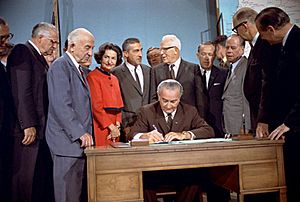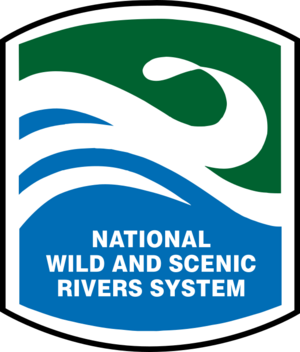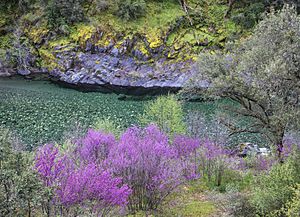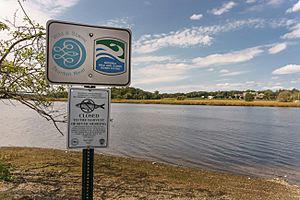National Wild and Scenic Rivers System facts for kids

The National Wild and Scenic Rivers System helps protect some of America's most special rivers. It was created by the Wild and Scenic Rivers Act of 1968. This law was passed by the U.S. Congress. Its main goal is to keep certain rivers flowing freely. These rivers have amazing natural beauty, important history, and great places for fun activities. The Act makes sure these rivers stay healthy for everyone, now and in the future.
This law is very important because it protects the unique qualities of these rivers. At the same time, it allows for careful use and development. It also encourages different groups, like federal and state governments, to work together to manage rivers. People living near the rivers are also asked to help decide how to protect them. President Lyndon B. Johnson signed this Act into law during a time when many new environmental laws were being created in the United States.
The Act says that certain rivers in the nation are special. They have amazing scenery, great spots for recreation, interesting geology, and important fish and wildlife. They also have historical or cultural value. These rivers should stay in their natural, free-flowing state. This protects them for everyone to enjoy, both now and in the future. The law also says that while dams are sometimes needed, we also need to protect other rivers. This helps keep their water clean and serves other important conservation goals.
The Wild and Scenic Rivers System was set up to protect and improve rivers that are important to their region and the whole country. Rivers can be added to this system by Congress. Or, if they meet certain rules, the Secretary of the Interior can add them. Each protected river is managed by a federal, state, or tribal agency. Sometimes, local groups called NGOs also help manage them. A river doesn't have to be protected along its entire length. Only certain parts, like its starting points or smaller streams that flow into it, can be included. For rivers managed by the federal government, the protected area usually extends about a quarter-mile on each side of the river. This helps protect everything important about the river.
As of August 2018, the system protects over 12,700 miles of 209 rivers. These rivers are in 40 states and Puerto Rico. This is a very small part of all the rivers in the U.S. (less than one-quarter of one percent). In comparison, more than 75,000 large dams have changed about 600,000 miles of American rivers. That's about 17% of all rivers!
Contents
Why Were Wild and Scenic Rivers Protected?
The idea for the National Wild and Scenic Rivers Act came from a special group called the Outdoor Recreation Resources Review Commission. This group suggested that the nation should protect wild and scenic rivers. They wanted to stop developments that would change their natural flow and value. At that time, many rivers were becoming polluted. Factories and cities were dumping waste into them. Many waterways and the fish living in them became toxic. This made them unsafe for nearby communities. Fish and other water animals were disappearing. Also, many people were forced to move from their homes because so many dams were being built. People all over the country wrote letters to the President and First Lady, asking them to save their favorite rivers.
The Act was supported by Senator Frank Church from Idaho. President Lyndon B. Johnson signed it into law on October 2, 1968. A river can be named a Wild and Scenic River by the U.S. Congress or the Secretary of the Interior.
In 1968, eight rivers were first named as National Wild and Scenic Rivers. These were the Clearwater, Eleven Point, Feather, Rio Grande, Rogue, St. Croix, Salmon, and Wolf. As of November 2018[update], there are 209 Wild and Scenic Rivers. They cover 12,754 miles in 40 states and Puerto Rico.
Rivers in the United States are protected because they have "Outstandingly Remarkable Values" (ORVs). These values fit into 8 groups:
- Scenic (beautiful views)
- Recreation (fun activities like kayaking)
- Geologic (interesting rocks and landforms)
- Fish (important for fish habitats)
- Wildlife (important for animals)
- Historic (important historical sites)
- Culture (important cultural sites)
- Other similar values
These values are like "ecosystem services". This means they are good things that nature provides for free, which help people. Rivers with this special protection are kept safe forever. Their free-flowing condition is protected from dams and other developments that would harm their special values. Being a Wild and Scenic River means that new dams cannot be built on or near the protected part of the river. It also protects the river from changes to its banks or channels that would hurt its values. It stops new oil, gas, and mineral mining on public lands along the river. Plus, it creates a special water right for the federal government. This right helps protect the river's flow, which is important for things like fish homes.
How Rivers Are Classified
Being named a Wild and Scenic River protects the natural flow of rivers. This is true for areas owned by the federal government and private lands. This protection is something other land protections, like the Wilderness Act, cannot do. It's important to know that this special river status does not change private property rights.
Federally managed Wild and Scenic Rivers are looked after by one or more of four main government agencies. Most of the 209 National Wild and Scenic Rivers are managed by the U.S. Forest Service. The National Park Service manages the next largest number. Some of these are official parts of national parks, while others are just within park boundaries. The rest are managed by the Bureau of Land Management and the U.S. Fish and Wildlife Service (mostly in Alaska).
Rivers managed by states get the same protections as federally managed rivers. These state rivers can be added to the National System by the Secretary of the Interior. This happens after the governor of the state where the river flows asks for it.
Protected rivers are given one or more classifications: Wild, Scenic, or Recreational. These classifications depend on how developed the area around the river was when it was protected.
- Wild rivers are the most remote and undeveloped. They feel very natural.
- Recreational rivers often have many places to access them. They might have roads, railroads, bridges, and homes nearby.
- Scenic rivers are somewhere in between Wild and Recreational. They have some development but still feel very natural.
It's important to remember that a river's classification doesn't mean that value is its most important feature. For example, a "Recreational" river might not have recreation as its most outstanding value. A "Scenic" river might not be protected mainly for its scenery. All Wild and Scenic Rivers get the same high level of protection, no matter their classification.
50th Anniversary of the Wild and Scenic Rivers Act
In 2018, America celebrated the 50th Anniversary of the Wild and Scenic Rivers Act. On August 2, 2018, 20 miles of East Rosebud Creek in Montana were named Wild and Scenic. This was the first new Wild and Scenic designation in Montana in over 40 years!
See also
 In Spanish: Río salvaje y paisajístico nacional (Estados Unidos) para niños
In Spanish: Río salvaje y paisajístico nacional (Estados Unidos) para niños




